Steel Corrosion Evaluation of Basalt Fiber RPC Affected by Crack and Steel-Concrete Interface Damage Using Electrochemical Methods
Abstract
:1. Introduction
2. Electrochemical Method
2.1. TPP Measurement
2.2. EIS Measurement
3. Experimental Details
3.1. Materials
3.2. Specimen Preparation
3.3. Test Procedure
3.4. Electrochemical Test
4. Result and Discussion
4.1. TPP Result
4.1.1. Tafel Curve Analysis
4.1.2. Corrosion Potential
4.1.3. Self-Corrosion Current Density
4.2. EIS Result
4.2.1. EIS Analysis
4.2.2. Resistance
4.3. Discussion
5. Conclusions
- (1)
- Cracks have a great influence on the steel corrosion of reinforced BFRPC, so the occurrence of cracks should be controlled in engineering.
- (2)
- BFRPC is different from conventional concrete due to its excellent compactness, preventing water and oxygen from reaching the steel bar location and preventing the adverse effects of SCID.
- (3)
- BF can effectively control the cracks generated by the expansion of corrosion products and extend the in-service life of the reinforced BFRPC.
Author Contributions
Funding
Conflicts of Interest
References
- Ba, G.; Miao, J.; Zhang, W.; Liu, J. Influence of reinforcement corrosion on fire performance of reinforced concrete beams. Constr. Build. Mater. 2019, 213, 738–747. [Google Scholar] [CrossRef]
- Mak, M.W.T.; Desnerck, P.; Lees, J.M. Corrosion-induced cracking and bond strength in reinforced concrete. Constr. Build. Mater. 2019, 208, 228–241. [Google Scholar] [CrossRef]
- Richard, P.; Cheyrezy, M. Composition of reactive powder concretes. Cem. Concr. Res. 1995, 25, 1501–1511. [Google Scholar] [CrossRef]
- Graybeal, B.A. Material Property Characterization of Ultra-High Performance; No. FHWA-HRT-06-103; Technical Report; Federal Highway Administration: McLean, VA, USA, 2006. [Google Scholar]
- Richard, P.; Cheyrezy, M.H. Reactive powder concretes with high ductility and 200–800 Mpa compressive strength. ACI Spring Conv. 1994, 144, 507–518. [Google Scholar]
- Wille, K.; Naaman, A.E.; Parra-Montesinos, G.J. Ultra-high performance concrete with compressive strength exceeding 150 MPa (22 ksi): A Simpler Way. ACI Mater. J. 2011, 108, 46–54. [Google Scholar]
- Liu, S.G.; Xiang, Z.; Huang, R.H.; Wang, D.H.; Ju, Y.Z. The durability of reactive powder concrete: A review. In Proceedings of the IOP Conference Series: Materials Science and Engineering, Xi’an, China, 1–4 November 2018; p. 012047. [Google Scholar]
- Aitcin, P.C. Cements of yesterday and today: Concrete of tomorrow. Cem. Concr. Res. 2000, 30, 1349–1359. [Google Scholar] [CrossRef]
- Ple, O.; Bayard, O. Preliminary study of multiscale analysis in fibre reinforced concrete. Mater. Struct. 2002, 35, 279–284. [Google Scholar] [CrossRef]
- Tang, K.K. Stray alternating current (AC) induced corrosion of steel fibre reinforced concrete. Corros. Sci. 2019, 152, 153–171. [Google Scholar] [CrossRef] [Green Version]
- Dadej, K.; Bienias, J.; Surowska, B. On the effect of glass and carbon fiber hybridization in fiber metal laminates: Analytical, numerical and experimental investigation. Compos. Struct. 2019, 220, 250–260. [Google Scholar] [CrossRef]
- Reihanian, M.; Dashtbozorg, M.; Baghal, S.M.L. Fabrication of glass/carbon fiber-reinforced Al-based composites through deformation bonding. J. Compos. Mater. 2019, 53, 2531–2543. [Google Scholar] [CrossRef]
- Abed, F.; Alhafiz, A.R. Effect of basalt fibers on the flexural behavior of concrete beams reinforced with BFRP bars. Compos. Struct. 2019, 215, 23–34. [Google Scholar] [CrossRef]
- Seis, M.; Beycioglu, A. Bond performance of basalt fiber-reinforced polymer bars in conventional Portland cement concrete: A relative comparison with steel rebar using the hinged beam approach. Sci. Eng. Compos. Mater. 2017, 24, 909–918. [Google Scholar] [CrossRef]
- Alnahhal, W.; Aljidda, O. Flexural behavior of basalt fiber reinforced concrete beams with recycled concrete coarse aggregates. Constr. Build. Mater. 2018, 169, 165–178. [Google Scholar] [CrossRef]
- Sarmah, M.; Roy, B.; Mozumder, R.A.; Laskar, A.I. Effect of Chopped Basalt Fibers on the Cyclic Behavior of RCC Beam-Column Subassemblies. Arab. J. Sci. Eng. 2018, 43, 1865–1874. [Google Scholar] [CrossRef]
- Xiong, Z.; Cai, Q.; Liu, F.; Li, L.; Long, Y. Dynamic performance of RAC-filled double-skin tubular columns subjected to cyclic axial compression. Constr. Build. Mater. 2020, 248, 118665. [Google Scholar] [CrossRef]
- Tang, Y.; Fang, S.; Chen, J.; Ma, L.; Li, L.; Wu, X. Axial compression behavior of recycled-aggregate-concrete-filled GFRP–steel composite tube columns. Eng. Struct. 2020, 216, 110676. [Google Scholar] [CrossRef]
- Gode, K.; Paegitis, A. Concrete Bridge Deterioration Caused by De-Icing Salts in High Traffic Volume Road Environment in Latvia. Balt J. Road Bridge Eng. 2014, 9, 200–207. [Google Scholar] [CrossRef] [Green Version]
- Vu, K.A.T.; Stewart, M.G. Structural reliability of concrete bridges including improved chloride-induced corrosion models. Struct. Saf. 2000, 22, 313–333. [Google Scholar] [CrossRef]
- Angst, U.M.; Geiker, M.R.; Alonso, M.C.; Polder, R.; Isgor, O.B.; Elsener, B.; Wong, H.; Michel, A.; Hornbostel, K.; Gehlen, C.; et al. The effect of the steel–concrete interface on chloride-induced corrosion initiation in concrete: A critical review by RILEM TC 262-SCI. Mater. Struct. 2019, 52, 88. [Google Scholar] [CrossRef]
- Otieno, M.; Golden, G.; Alexander, M.G.; Beushausen, H. Acceleration of steel corrosion in concrete by cyclic wetting and drying: Effect of drying duration and concrete quality. Mater. Struct. 2019, 52, 50. [Google Scholar] [CrossRef]
- Hay, R.; Ostertag, C.P. Influence of transverse cracks and interfacial damage on corrosion of steel in concrete with and without fiber hybridization. Corros. Sci. 2019, 153, 213–224. [Google Scholar] [CrossRef]
- Chen, F.; Li, C.-Q.; Baji, H.; Ma, B. Effect of design parameters on microstructure of steel-concrete interface in reinforced concrete. Cem. Concr. Res. 2019, 119, 1–10. [Google Scholar] [CrossRef]
- Dubuc, B.; Ebrahimkhanlou, A.; Salamone, S. Corrosion monitoring of prestressed concrete structures by using topological analysis of acoustic emission data. Smart Mater. Struct. 2019, 28, 055001. [Google Scholar] [CrossRef]
- Ming, J.; Shi, J. Distribution of corrosion products at the steel-concrete interface: Influence of mill scale properties, reinforcing steel type and corrosion inducing method. Constr. Build. Mater. 2019, 229, 116854. [Google Scholar] [CrossRef]
- Tang, Y.; Li, L.; Wang, C.; Chen, M.; Feng, W.; Zou, X.; Huang, K. Real-time detection of surface deformation and strain in recycled aggregate concrete-filled steel tubular columns via four-ocular vision. Robot. CIM Manuf. 2019, 59, 36–46. [Google Scholar] [CrossRef]
- Fan, L.; Bao, Y.; Meng, W.; Chen, G. In-situ monitoring of corrosion-induced expansion and mass loss of steel bar in steel fiber reinforced concrete using a distributed fiber optic sensor. Compos. Part B: Eng. 2019, 165, 679–689. [Google Scholar] [CrossRef]
- Otieno, M.; Ikotun, J.; Ballim, Y. Experimental investigations on the influence of cover depth and concrete quality on time to cover cracking due to carbonation-induced corrosion of steel in RC structures in an urban, inland environment. Constr. Build. Mater. 2019, 198, 172–181. [Google Scholar] [CrossRef]
- Fahim, A.; Dean, A.E.; Thomas, M.D.A.; Moffatt, E.G. Corrosion resistance of chromium-steel and stainless steel reinforcement in concrete. Mater. Corros. 2019, 70, 328–344. [Google Scholar] [CrossRef]
- Gunasekara, C.; Law, D.; Bhuiyan, S.; Setunge, S.; Ward, L. Chloride induced corrosion in different fly ash based geopolymer concretes. Constr. Build. Mater. 2019, 200, 502–513. [Google Scholar] [CrossRef]
- Monzon, P.; Ramon, J.E.; Gandia-Romero, J.M.; Valcuende, M.; Soto, J.; Palaci-Lopez, D. PLS multivariate analysis applied to corrosion studies on reinforced concrete. J. Chemometr. 2019, 33, e3096. [Google Scholar] [CrossRef]
- Duprat, F.; de Larrard, T.; Vu, N.T. Quantification of Tafel coefficients according to passive/active state of steel carbonation-induced corrosion in concrete. Mater. Corros. 2019, 70, 1934–1963. [Google Scholar] [CrossRef]
- Chang, Z.T.; Cherry, B.; Marosszeky, M. Polarisation behaviour of steel bar samples in concrete in seawater. Part 2: A polarisation model for corrosion evaluation of steel in concrete. Corros. Sci. 2008, 50, 3078–3086. [Google Scholar] [CrossRef]
- Soleymani, H.R.; Ismail, M.E. Comparing corrosion measurement methods to assess the corrosion activity of laboratory OPC and HPC concrete specimens. Cem. Concr. Res. 2004, 34, 2037–2044. [Google Scholar] [CrossRef]
- Ghafari, E.; Arezoumandi, M.; Costa, H.; Julio, E. Influence of nano-silica addition on durability of UHPC. Constr. Build. Mater. 2015, 94, 181–188. [Google Scholar] [CrossRef]
- Reou, J.S.; Ann, K.Y. Electrochemical assessment on the corrosion risk of steel embedment in OPC concrete depending on the corrosion detection techniques. Mater. Chem. Phys. 2009, 113, 78–84. [Google Scholar] [CrossRef]
- Liu, H.; Liu, S.; Wang, S.; Gao, X.; Gong, Y. Effect of Mix Proportion Parameters on Behaviors of Basalt Fiber RPC Based on Box-Behnken Model. Appl. Sci. 2019, 9, 2031. [Google Scholar] [CrossRef] [Green Version]
- ASTM C876–09. Standard Test Method for Corrosion Potentials of Uncoated Reinforcing Steel in Concrete; American Society for Testing and Materials: West Conshohocken, PA, USA, 2009; Available online: http:www.astm.org (accessed on 15 December 2019).
- Michel, A.; Solgaard, A.O.S.; Pease, B.J.; Geiker, M.R.; Stang, H.; Olesen, J.F. Experimental investigation of the relation between damage at the concrete-steel interface and initiation of reinforcement corrosion in plain and fibre reinforced concrete. Corros. Sci. 2013, 77, 308–321. [Google Scholar] [CrossRef]
- Lan, C.M.; Tuerhan, M.; Liu, C.P.; Li, H.; Spencer, B.F. Monitoring of chloride-induced corrosion in steel rebars. Corros. Eng. Sci. Techn. 2018, 53, 601–610. [Google Scholar] [CrossRef]
- Li, S.B.; Hu, B.X.; Zhang, F. Investigation of Chloride Corrosion Process of Cement and Concrete-Based Materials Based on Electrochemical Impedance Spectroscopy. J. Nanoelectron. Optoelectron. 2017, 12, 1244–1250. [Google Scholar] [CrossRef]
- Konin, A.; François, R.; Arliguie, G. Analysis of progressive damage to reinforced ordinary and high performance concrete in relation to loading. Mater. Struct. 1998, 31, 27–35. [Google Scholar] [CrossRef]
- Nasser, A.; Clement, A.; Laurens, S.; Castel, A. Influence of steel-concrete interface condition on galvanic corrosion currents in carbonated concrete. Corros. Sci. 2010, 52, 2878–2890. [Google Scholar] [CrossRef]
- Soylev, T.A.; Francois, R. Corrosion of reinforcement in relation to presence of defects at the interface between steel and concrete. J. Mater. Civil Eng. 2005, 17, 447–455. [Google Scholar] [CrossRef]
- Yonezawa, T.; Ashworth, V.; Procter, R. Pore solution composition and chloride effects on the corrosion of steel in concrete. Corrosion 1988, 44, 489–499. [Google Scholar] [CrossRef]
- Ju, Y.; Tian, K.P.; Liu, H.B.; Reinhardt, H.W.; Wang, L. Experimental investigation of the effect of silica fume on the thermal spalling of reactive powder concrete. Constr. Build. Mater. 2017, 155, 571–583. [Google Scholar] [CrossRef]
- Cao, S.J.; Hou, X.M.; Rong, Q.; Li, G. Dynamic splitting tensile test of hybrid-fiber-reinforced reactive powder concrete. Emerg. Mater. Res. 2018, 7, 52–57. [Google Scholar] [CrossRef]
- Chen, X.; Wan, D.W.; Jin, L.Z.; Qian, K.; Fu, F. Experimental studies and microstructure analysis for ultra high-performance reactive powder concrete. Constr. Build. Mater. 2019, 229, 116924. [Google Scholar] [CrossRef]



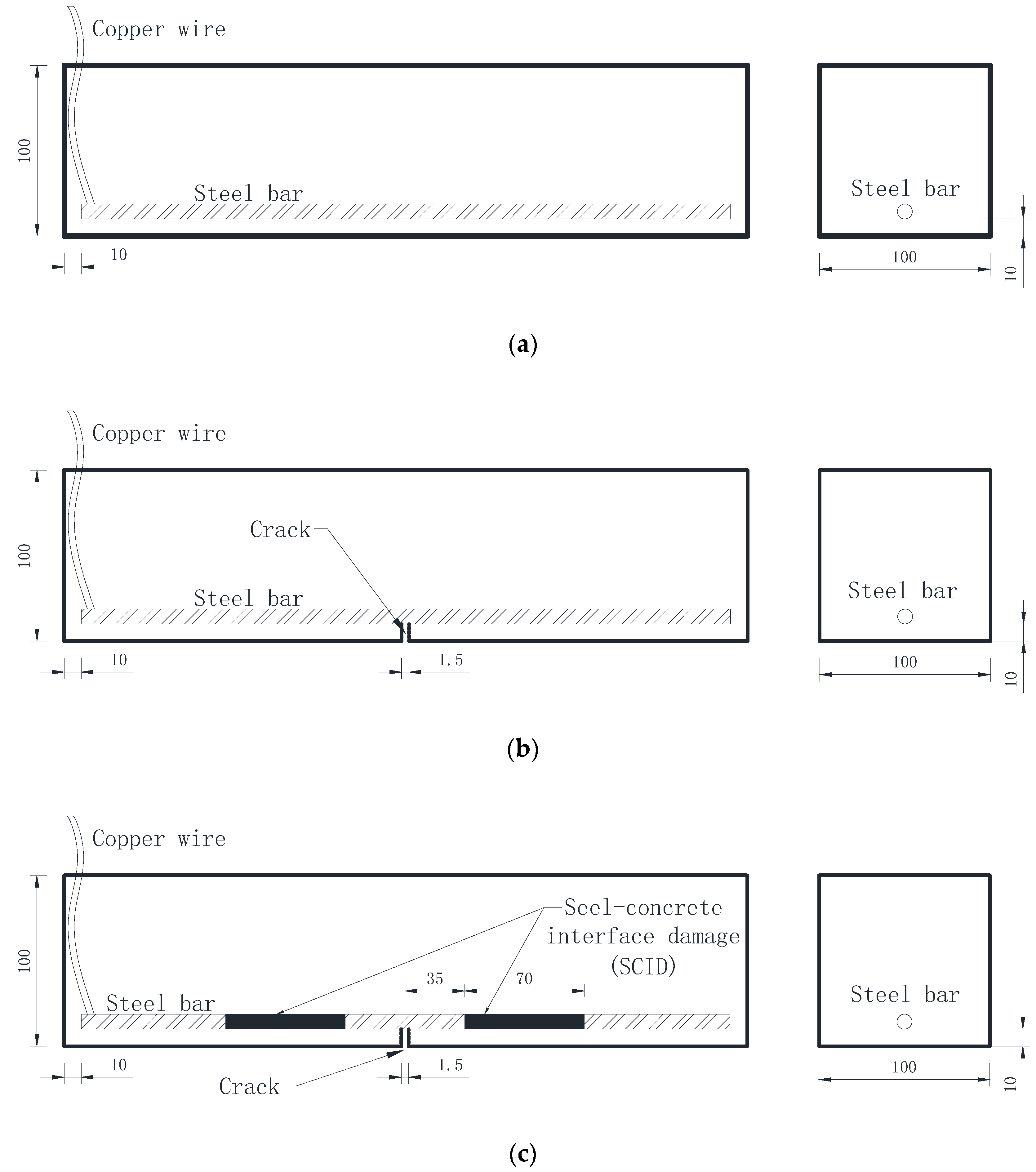


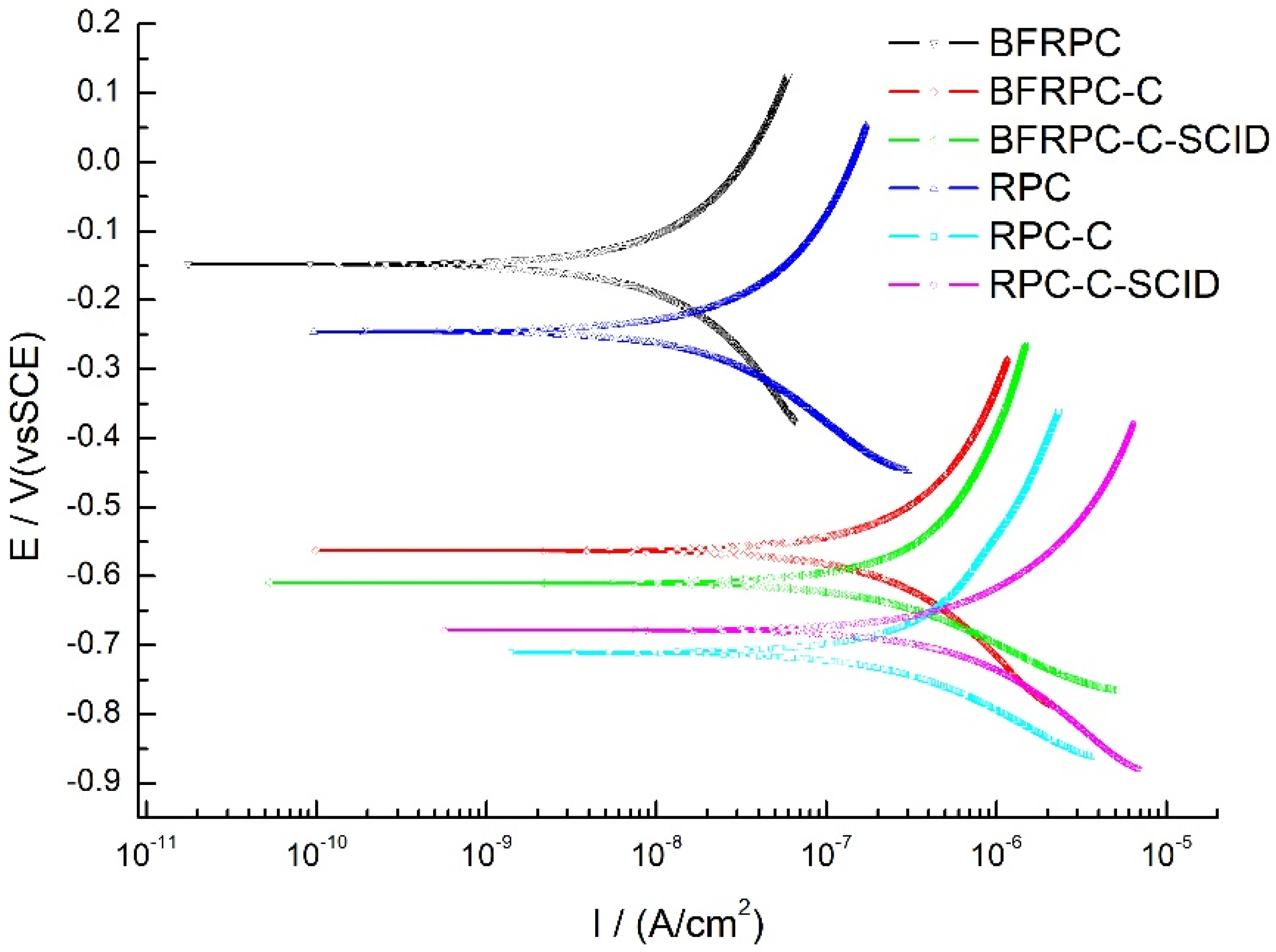
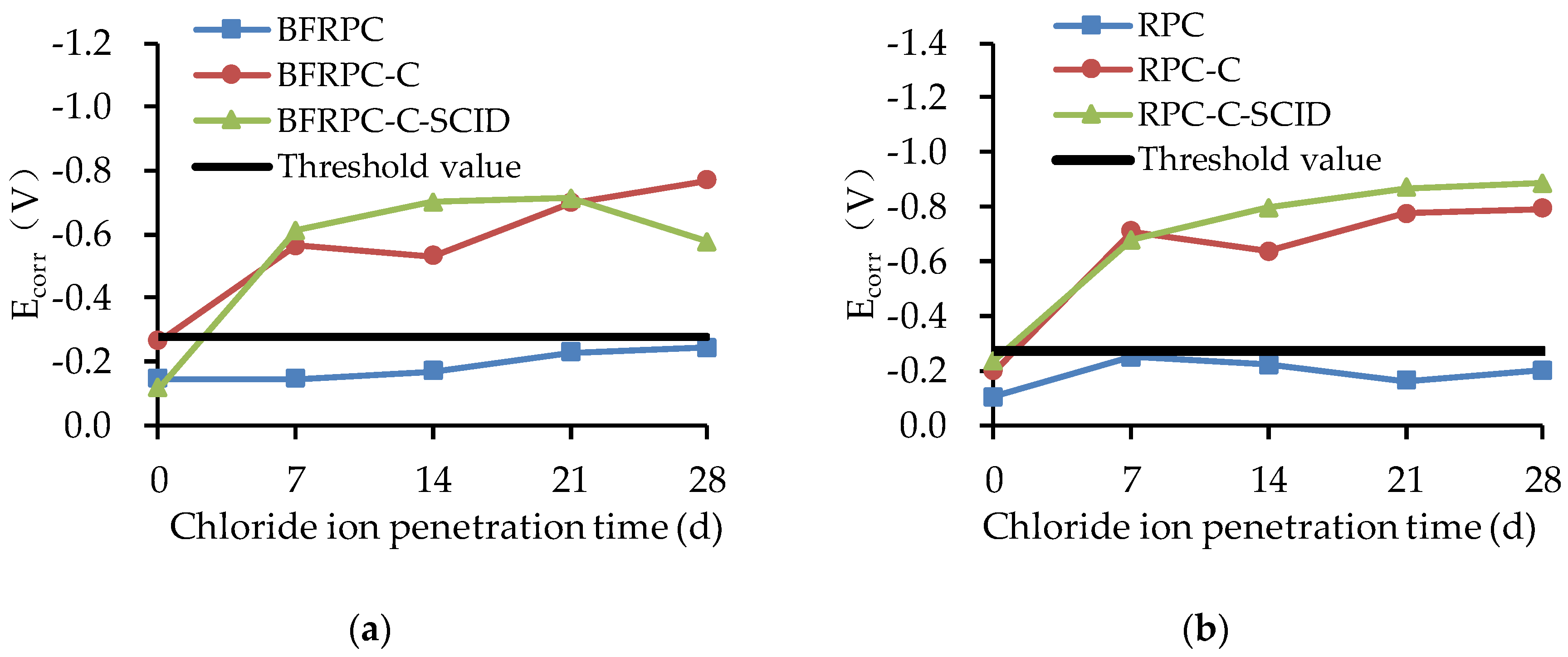
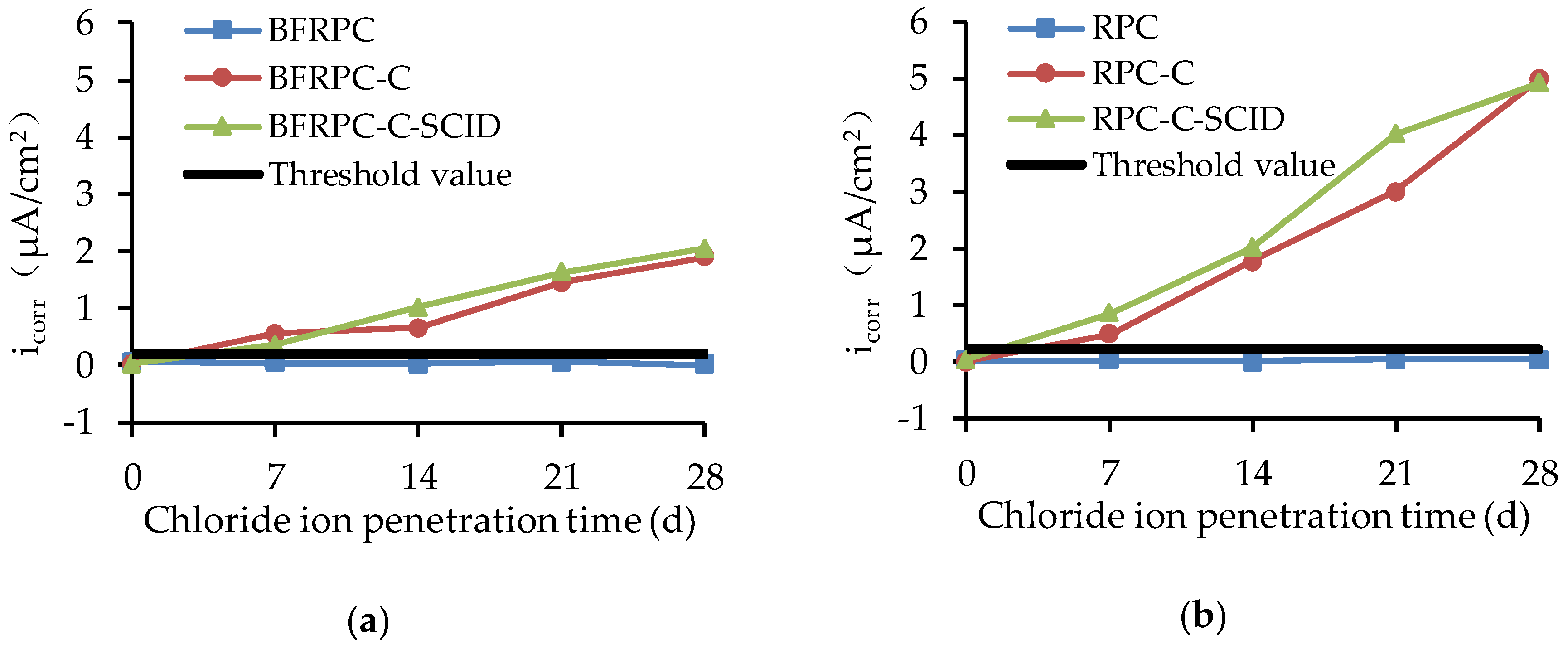
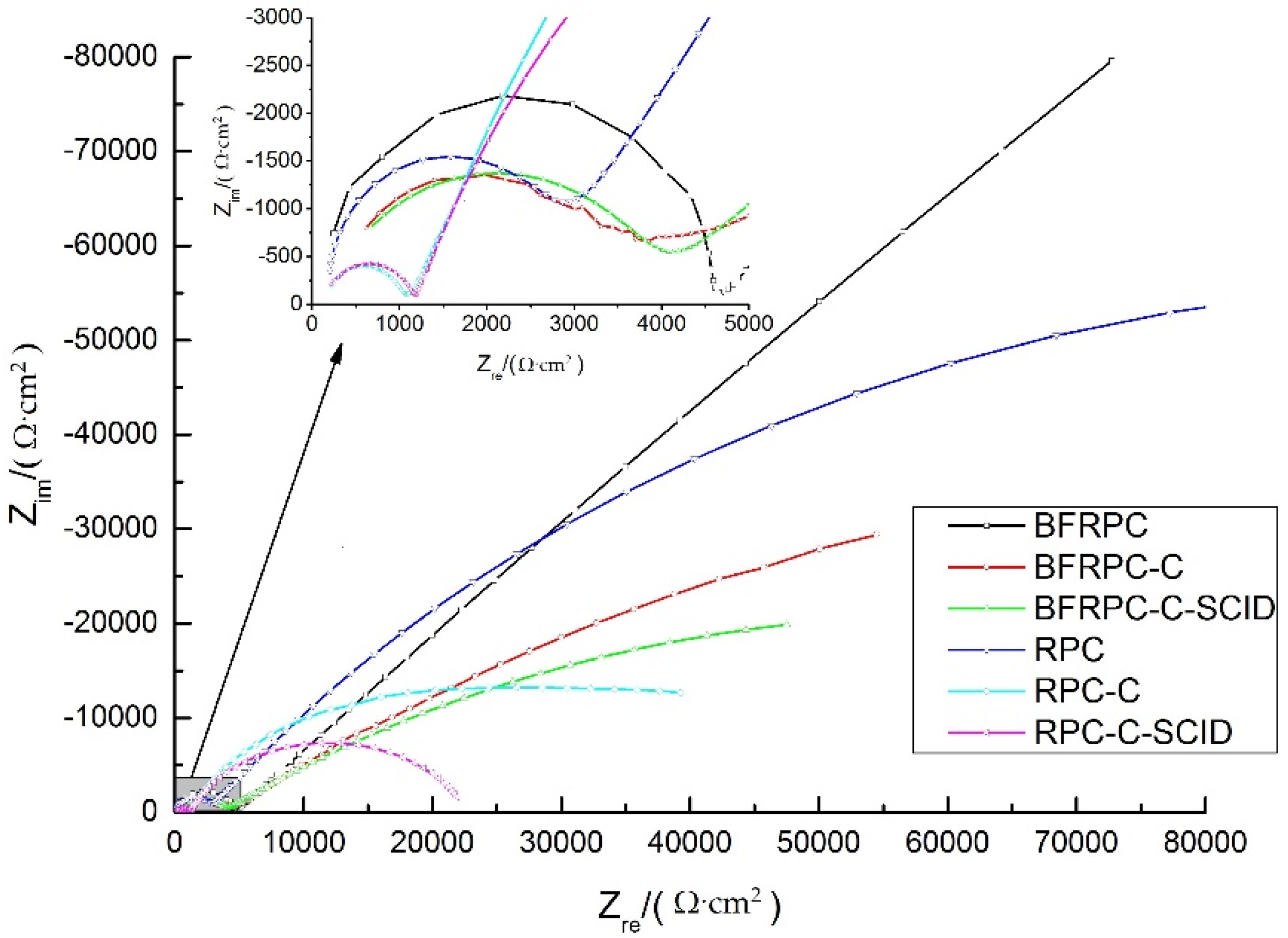
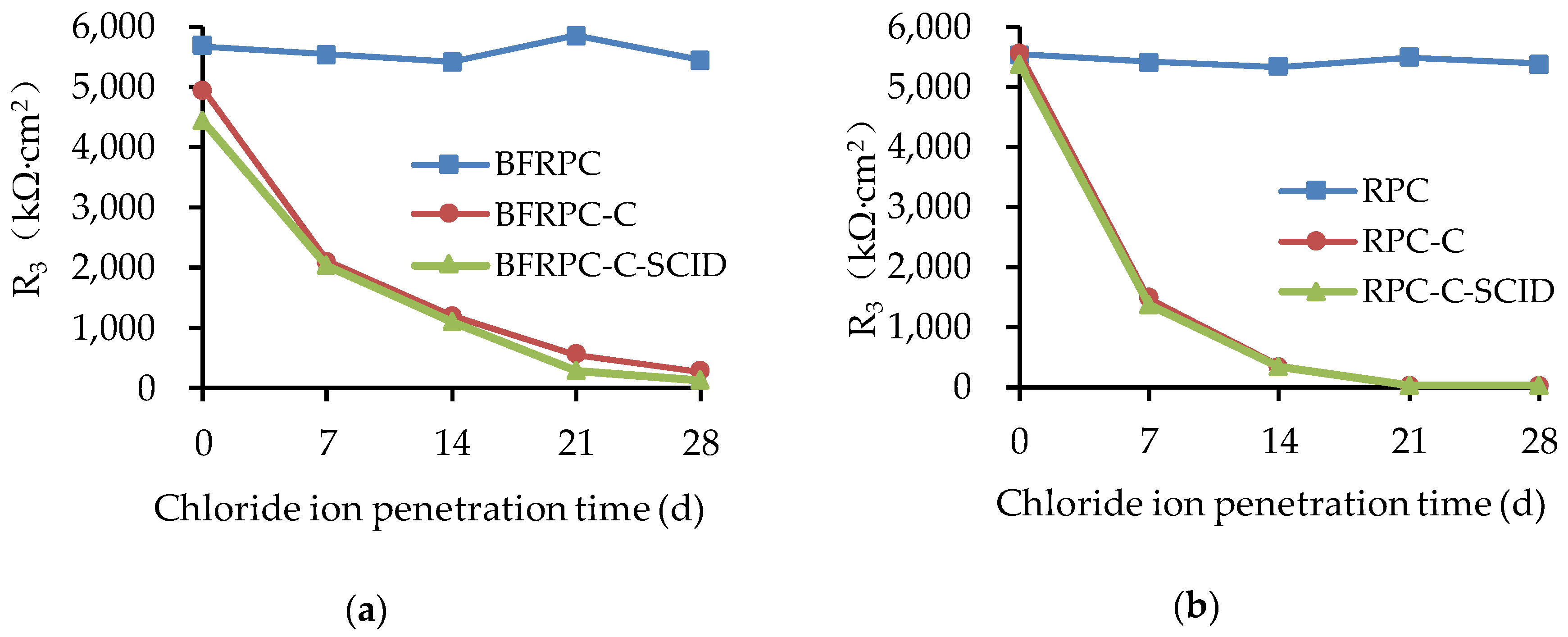

| Fiber Type | Length (mm) | Diameter (μm) | Linear Density (tex) | Tensile Strength (MPa) | Elastic Modulus (GPa) | Breaking Strength (N/tex) | Elongation (%) |
|---|---|---|---|---|---|---|---|
| Basalt fiber | 22 | 23 | 2392 | 2836 | 62 | 0.69 | 3 |
| Water | Cement | Silica | Quartz Sand | Quartz Powder | Basalt Fiber | Water | ||
|---|---|---|---|---|---|---|---|---|
| Fume | 0.15 mm–0.3 mm | 0.3 mm–0.6 mm | Reducer | |||||
| BFRPC | 151.5 | 841.8 | 210.4 | 364.2 | 582.8 | 311.4 | 12 | 52.6 |
| RPC | 151.5 | 841.8 | 210.4 | 364.2 | 582.8 | 311.4 | 0 | 52.6 |
| Specimen Types | Crack | Steel-Concrete Interface Damage (SCID) |
|---|---|---|
| BFRPC; RPC | ○ | ○ |
| BFRPC-C; RPC-C | ● | ○ |
| BFRPC-C-SCID; RPC-C-SCID | ● | ● |
| Specimen Number | ba (mV/Decade) | bc (mV/Decade) | icorr (μA/cm2) | Ecorr (V) |
|---|---|---|---|---|
| BFRPC | 371.580 | 159.118 | 0.042 | −0.146 |
| BFRPC-C | 471.483 | 397.299 | 0.545 | −0.563 |
| BFRPC-C-SCID | 678.020 | 295.855 | 0.357 | −0.609 |
| RPC | 257.130 | 233.506 | 0.029 | −0.248 |
| RPC-C | 504.852 | 188.842 | 0.492 | −0.711 |
| RPC-C-SCID | 635.045 | 525.975 | 0.848 | −0.678 |
| R1 (Ω·cm2) | CPE1-T (μF·cm2) | CPE1-P (μF·cm2) | R2 (Ω·cm2) | CPE2-T (μF·cm2) | CPE2-P (μF·cm2) | R3 (kΩ·cm2) | |
|---|---|---|---|---|---|---|---|
| BFRPC | 175.0 | 5.139 × 10−8 | 1.22 | 4702 | 3.45 × 10−7 | 0.57 | 5093 |
| BFRPC-C | 145.9 | 2.434 × 10−8 | 0.79 | 3604 | 4.71 × 10−5 | 0.43 | 279.55 |
| BFRPC-C-SCID | 134.6 | 2.48 × 10−8 | 0.78 | 3654 | 4.60 × 10−5 | 0.44 | 114.49 |
| RPC | 203.2 | 9.23 × 10−8 | 1.05 | 2836 | 3.24 × 10−7 | 0.63 | 2531 |
| RPC-C | 138.0 | 2.67 × 10−8 | 0.89 | 942 | 3.57 × 10−5 | 0.72 | 40.81 |
| RPC-C-SCID | 155.2 | 3.24 × 10−8 | 0.87 | 1027 | 3.61 × 10−5 | 0.74 | 24.94 |
© 2020 by the authors. Licensee MDPI, Basel, Switzerland. This article is an open access article distributed under the terms and conditions of the Creative Commons Attribution (CC BY) license (http://creativecommons.org/licenses/by/4.0/).
Share and Cite
Liu, H.; Lyu, X.; Zhang, Y.; Luo, G.; Li, W. Steel Corrosion Evaluation of Basalt Fiber RPC Affected by Crack and Steel-Concrete Interface Damage Using Electrochemical Methods. Sensors 2020, 20, 5027. https://doi.org/10.3390/s20185027
Liu H, Lyu X, Zhang Y, Luo G, Li W. Steel Corrosion Evaluation of Basalt Fiber RPC Affected by Crack and Steel-Concrete Interface Damage Using Electrochemical Methods. Sensors. 2020; 20(18):5027. https://doi.org/10.3390/s20185027
Chicago/Turabian StyleLiu, Hanbing, Xiang Lyu, Yuwei Zhang, Guobao Luo, and Wenjun Li. 2020. "Steel Corrosion Evaluation of Basalt Fiber RPC Affected by Crack and Steel-Concrete Interface Damage Using Electrochemical Methods" Sensors 20, no. 18: 5027. https://doi.org/10.3390/s20185027





